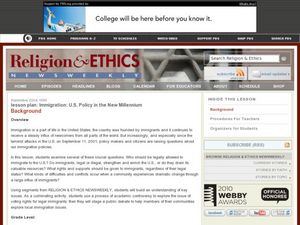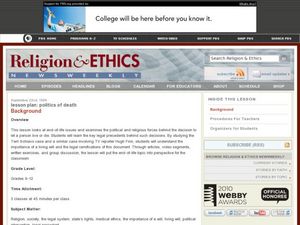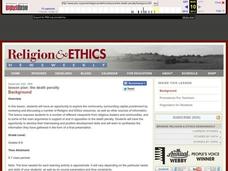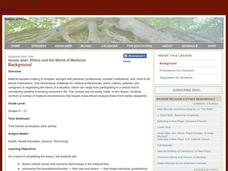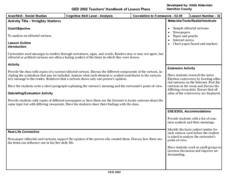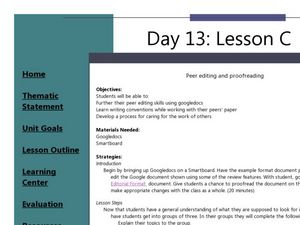Curated OER
Immigration: U.S. Policy in the New Millennium
Students explore U.S. immigration policies. In this immigration lesson, students read about the history of immigration policies in the U.S., uncover controversial issues regarding immigration, and speak to immigrants as well as...
Curated OER
Politics of Death
Students examine the topic of euthanasia. In this religion and ethics lesson plan, students investigate the cases of Terri Schiavo and Hugh Finn in order to gain an understanding of the euthanasia controversy.
Curated OER
The Death Penalty
Young scholars examine the controversy surrounding the death penalty in the United States. In this current events lesson plan, students research the history of the death penalty as well perspectives on the topic. Young scholars interview...
Curated OER
Best Friend - Friend from Hell
Students practice in a number of areas: expressing opinions, using comparatives and superlatives, descriptive adjectives and reported speech. The overall concept of this lesson can be applied to many other topics of discussion.
Curated OER
Ethics and the World of Medicine
Students examine ethical issues in the field of medicine. In this ethics instructional activity, students explore primary and secondary sources regarding the discernment that medical professionals are presented with as they treat...
Curated OER
The Cuban Missile Crisis
High schoolers reflect on the events that lead up to the Cuban Missile Crisis in the early 1960s. In this history lesson plan, students explore the conflicts between the United States and the Soviet Union revolving around missiles...
Channel Islands Film
Cache: Lesson Plan 3 - Grades 4-5
Should the excavation of what is believed to be the cave of the Lone Woman of San Nicholas Island be allowed to continue? As a practice exercise designed to prepare pupils for a timed writing exam, individuals read two Los Angeles...
Curated OER
Creating a Newspaper
Get the scoop with a fun, engaging newspaper project. After analyzing the parts of a newspaper, including the headline, subtitles, and pictures or images, young journalists get to work by writing their own stories in a newspaper article...
City University of New York
Women's Suffrage and World War I
Democracy cannot exist where not everyone has equal rights. Discuss the state of democracy and women's suffrage during World War I with class discussions, debates, and primary source analysis, in order for class members to connect...
American Press Institute
Newspapers in Your Life: What’s News Where?
Big news isn't necessarily newsworthy everywhere! How do journalists decide what to cover with so much happening around them? A instructional activity on media literacy examines the factors that affect the media's choice of stories to...
University of North Carolina
Audience
Challenging pupils' perspectives by having them walk in the shoes of the reader. An informative resource discusses how to identify an audience and anticipate their needs before writing an upcoming argumentative essay.
Curated OER
Weighty Matters
Students analyze political cartoons, and write short paragraphs explaining the cartoon's meaning and the cartoonist's point-of-view.
Curated OER
Spedwards Times
Students research parts of existing newspapers by having a newspaper treasure hunt. Students glue pieces found on poster board with headings. Students meet and interview a newspaper reporter. Students create a name and masthead for...
Curated OER
The Red Kangaroo: An Outback Survivor
Students watch an episode of "Nature" about the "Big Red Roos." They create food chains and webs based on the information they've researched on the red kangaroos. They write an editorial on the topic of the killing of kangaroos in the...
Curated OER
Speak Out!
Students consider their opinions on various topics and issues related to the terrorist attacks on the United States on September 11, 2001. Then, focusing on one specific topic, each student supports his or her opinions in a...
Curated OER
Peer Editing and Proofreading
Students present their editorials to a small group and peer edit and proofread the papers. In this peer editing and proofreading lesson, students watch as the instructor models a peer editing on the Smart Board. Students work...
Curated OER
Fact or Opinion?
Third graders design a political cartoon. In this fact and opinion lesson, 3rd graders examine political cartoons and distinguish fact from opinion. Students create a political cartoon on the topic of their choice.
Curated OER
Persuasive Writing Lesson Plan: Dress Codes
Students examine the pros and cons of the implementation of public policy matters and the specific issue of dress codes. They develop a list of pros and cons of a school dress code, examine and discuss a local editorial newspaper page,...
Curated OER
Newspapers
Middle schoolers create a class newspaper about the Olympics. In this newspaper lesson, students discuss the basic characteristics of each component of the newspaper. Middle schoolers work in small groups to complete stations...
Curated OER
Summarizing
Students summarize articles, editorials, and news programs. In this writing skills lesson, students take notes on news stories about one issue from more than one source and then write summaries of the issue using rule-based summary...
Curated OER
Rhetorical Devices
Eleventh graders consider rhetorical devices in speeches and then make an informed selection of effective rhetorical devices for a controversial topic presentation. Students present their findings using presentation software.
Curated OER
Rhetorical Devices
Twelfth graders identify and analyze examples of rhetorical devices as valid or invalid inferences. In this text analysis lesson, 12th graders research a controversial topic in teams and identify rhetorical devices for the topic....
Curated OER
Discriminating Issues
Young scholars examine how U.S. Law Defines Discrimination In this lesson. They research the issues surrounding a variety of types of discrimination, and then write editorials analyzing legal and social positions on discrimination in the...
Curated OER
Focus on the Media
Students critically examine news articles and editorials for attitudes of discrimination and prejudice. Students then complete checklist in which they analyze news reports for context, content, point of view, language, graphics, and...


